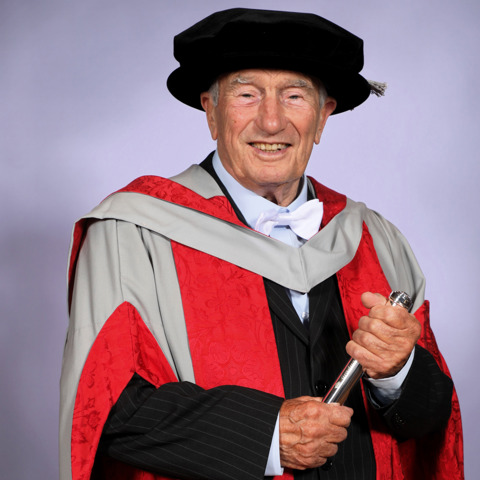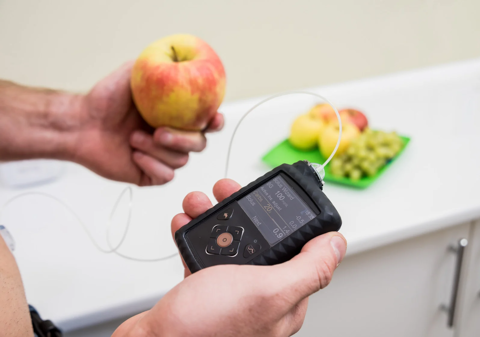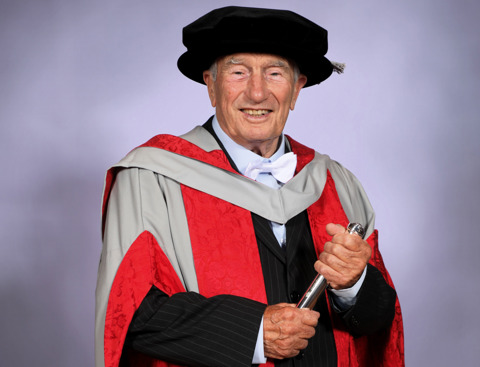
Honorary degree for insulin pump pioneer
Robert Channon has received an honorary degree for his role in developing insulin pumps.
An honorary degree has been awarded to an engineer whose work played a key role in improving the lives of people living with type 1 diabetes.
Robert Channon recently received an Honorary Doctor of Engineering degree from the University of the West of England (UWE Bristol) in recognition of his pioneering work that changed the administration of insulin during the 1970s and 1980s.
Robert received a standing ovation when presented with the honour at a graduation ceremony at Bristol Beacon on 17th July.
He is among nine people receiving honorary degrees at UWE Bristol graduation ceremonies this month, in recognition of outstanding achievements in their chosen fields and significant contributions to Bristol.
Robert was celebrated for a remarkable career that began with the development of the first programmable insulin pump, allowing different rates of insulin infusion.
The compact, battery-powered insulin infusion pump developed in 1979 weighed just three ounces.
He later developed the Portaject, the first device that allowed convenient repeated subcutaneous injections of insulin and the forerunner to the Novopen.
Administration of insulin using Robert’s method resulted in improved control of patients’ diabetes and improved prognosis. His work made a significant global contribution to the care and management of people with type 1 diabetes.

In his early career Robert qualified as a marine engineering designer and working as an officer in the Merchant Navy he was more familiar with the engines of steam ships than medical devices.
However, when he was diagnosed with type 1 diabetes he was inspired to turn his knowledge to projects that could benefit others living with the condition.
On diagnosis, Robert was referred to Guy’s Hospital under the care of Professor Keen who recommended that he may benefit from a continuous insulin infusion pump which might improve the control of his diabetes.
During his apprenticeship at Charles Hill in the drawing office, at the age of 17 he designed the pump room of a ship named the Harry Brown to suck sand from the Bristol Channel. This led to knowledge of fluids and became a natural progression years later to design the first infusion pump.
His academic work in the study of corrosive science stood him in good stead when he later considered the feasibility of a blood glucose sensor which could be linked to an infusion pump.
Robert set to work on an old lathe in his garden shed where he designed and built an insulin pump driven by a small compression spring that had the ability to deliver different rates of insulin, therefore providing a background bolus regime of insulin that could be increased or decreased depending on blood glucose levels, often as a function of carbo-hydrate intake.
The prototype of the design, based on a unique concept, is now part of the Bristol Museums Collection.
Robert tested the device on himself whilst travelling between Bath and Guy’s Hospital in London, researching different infusion systems. His second-generation insulin infusion pump, with the attachment of an interstitial sensor, demonstrated the feasibility of a closed loop insulin delivery system, or artificial pancreas.
He was released from his lecturing role at City of Bath Technical College and seconded to Guy’s Hospital. To enable people living with diabetes who were deaf and/or blind to retain their independence he also developed an insulin syringe with an audible and tactile click so that they could safely inject the required dose of insulin.

In the 1980s Robert moved to Bristol Royal Infirmary where he designed and tested in conjunction with Drs Martin Hartog and Richard Paisley the precursor to the Novopen.
Robert built the Portaject, the first device to allow convenient repeated injections of insulin to suit carbohydrate intake. Along with a 24-hour background insulin capacity, this had the benefit of improved glycaemic control and in consequence a reduction in additional complications. The treatment, known as background/bolus, has been in use since the early 1980s and has proved to have extended the lives of millions of insulin dependent people with diabetes worldwide.
Robert’s innate ability to analytically appraise, and his insatiable desire to solve problems or improve situations for his fellow humans, has led to several other inventions. These include contributions to projects including unmanned helicopters for the military to detect landmines and robots to save the lives of sewage workers.
Robert said: “My association with UWE Bristol spans over six decades, as I attended the forerunner to this university in buildings known as Muller orphanage and obtained my engineering qualifications through this organisation. To receive this degree is truly a great honour and an enormous privilege.
“My advice for all graduates and students at the university is that if in doubt, believe in yourself, look closely and scientifically at problems, and postulate how nature resolves them.”
I would like to make a regular donation of
I would like to make a single donation of
There are lots of ways to raise money to support
people living with all forms of diabetes.
Bake, Swim, Cycle, Fly ... Do It For DRWF!
Fundraise with us
Recent News


